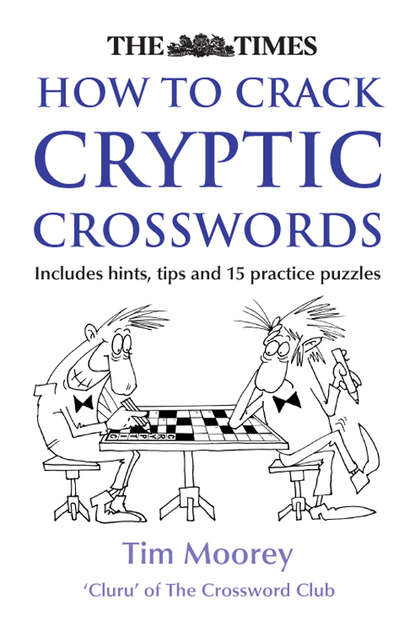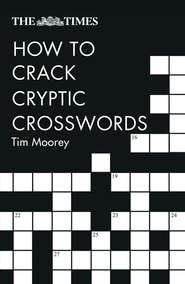По всем вопросам обращайтесь на: info@litportal.ru
(©) 2003-2024.
✖
The Times How to Crack Cryptic Crosswords
Настройки чтения
Размер шрифта
Высота строк
Поля
‘Do something that is mentally challenging to you,’ he has said. ‘It seems that remaining mentally agile makes the brain more healthy and more likely to resist illness, just as physical exercise can protect the body from disease.’
In addition, are crosswords educational? I say yes, in the sense that they can improve your vocabulary and general knowledge.
Incidentally, you can check the number of words in your vocabulary via, amongst other sites, www.testyourvocab.com (http://www.testyourvocab.com), against the average native English speaker’s 27,000 words. Maybe one plan is for you to check your score again after you have mastered this book!
It’s now time to get stuck into some basics, in which I assume no previous knowledge whatever.
PART 1: (#ulink_532370fb-718b-5ceb-9118-0a9087d13249)
CROSSWORD BASICS (#ulink_532370fb-718b-5ceb-9118-0a9087d13249)
1: Terminology (#ulink_1d77eebd-ea60-5ba6-ac6b-5d7398ef18ee)
‘She had another look at The Times Crossword. The clues might as well have been written in a foreign language.’
Simon Brett, The Stabbing in the Stables
The first three chapters establish the terms used throughout. They are essential reading for beginners, and perhaps also for some seasoned solvers who may have become used to different terminology.
What is a cryptic clue?
A cryptic clue is a sentence or phrase, involving a degree of deception, making sense and frequently conjuring an image, or triggering thoughts, in its surface reading, but when read in another way can be decoded using a limited number of well-established techniques to give a solution. Thus ‘cryptic’ is used in its meaning of hidden or misleading.
These are the other terms we shall use:
• Answers to clues, running across and down are entered into a grid, popularly a diagram, which has across and down empty squares to be filled.
• The grids in the case of the puzzles we are considering here contain black square blocks, hence they are seen in blocked puzzles.
• The other main type not being considered here has a grid with bars rather than blocks, hence the term barred puzzles.
• Clue answers are variously called solutions, entries and indeed answers.
• Where a solution letter, or letters, is able to be confirmed by intersecting entries, they are checked letters. Unchecked letters (unches in the trade) are therefore the opposite: the solver has no second way of confirming them.
• The person responsible for the crossword is a setter; more commonly, but in a term less attractive to most crossword professionals, a compiler.
• The term constructor, which suits puzzles with difficult- to-build grids, is used in North America.
• Other terms associated with clues such as wordplay, anagram, indicator and anagram fodder are explained as we meet them.
For completeness, there is a rarely used crossword term – light – whose meaning has fluctuated somewhat from the early days of crosswords but is defined by the Collins English Dictionary today as the solution to a clue.
ARE CRYPTICS EXCLUSIVELY BRITISH?
Commonwealth countries such as Canada, Australia, New Zealand, India, Kenya, Malta and South Africa have daily cryptics similar to British ones, as does Ireland. US crosswords are different in that grids are more open and clues are mildly cryptic or straightforward definitions. There are some occasional British-style puzzles in the New York Times and elsewhere. Nonetheless the UK can be considered the home of cryptics. For example, Daily Telegraph crosswords are syndicated to around 20 countries.
2: Overview of Clues and Indicators (#ulink_56d0a4f4-1810-575e-9d02-51c6bb7e95ac)
‘The question is,’ said Alice, ‘whether you can make words mean so many different things.’
Lewis Carroll, Through the Looking Glass
In this chapter I provide a short overview of the basics of clues and how to recognize them. Detailed points on each clue type are the subject of Chapter 3 (#uad6b2df8-933b-5385-9c6c-eb49490558be).
Characteristics of a cryptic clue
We will consider twelve types of cryptic clue, of which the majority conform to the principles contained in this image:
Cryptic clues (mostly) have two parts
Either the definition or the wordplay can come first in the clue sentence; and either could be exploited first to obtain the solution. Whichever does come second in your solving order acts as confirmation that you have the correct solution.
Taking each element in turn:
Definition: The definition can
• take the form of a word, or words in a phrase
• be an example of the solution (e.g. fruit can be defined as apple, perhaps)
• be a (misleadingly expressed) synonym of the solution. To this end, definitions are often words that have more than one meaning
Wordplay: This is the way to elicit the solution if the definition does not do so. It can be seen as either:
• the letters of the solution needing manipulation in one of several ways to provide another indication of the definition, or
• individual word or words in the clue having to be interpreted in a different way from the surface meaning
Perhaps strictly accurately the terms should be word and letterplay (though not, as an elderly student once stumbled over, ‘loveplay’!).
TOP TIP – DEFINITION PLACEMENT
Beginners find it much easier to decode a cryptic clue when they are told that the definition is almost always either at the beginning or end of the clue sentence or phrase.
Solution: This can be one or more words whose word-length is shown at the end of the clue in parentheses (sometimes called the enumeration).
An example of how this works is seen in this clue which has a simple juxtaposition of three parts from which the solver has to discover which parts are which before progress can be made. Here it could be that either find or above is the definition. In fact it is find.
Find record above (8)
Linkwords: Few clues are as straightforward in construction as the previous example and the first mild challenge is that there is often a linkword between the two parts to give the solution. The chart then is:
CRYPTIC CLUES WITH LINKING WORDS
Below is a clue which also starts with the definition but, in addition, has a linkword, one that is commonly used: from. The sense conveyed by from is that a synonym for church house can be formed from the two parts earlier and years (if the latter is taken as an abbreviation – more on this later).
Church house from earlier years (6)






